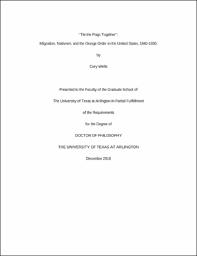| dc.description.abstract | “Tie the Flags Together”:
Migration, Nativism, and the Orange Order in the United States, 1840-1930
Cory Wells
Throughout the nineteenth century, tens of thousands of Irish Protestants who migrated to the United States joined the Orange Order in their newly adopted country. Formed in Ulster in the 1790s, the Loyal Orange Institution existed to maintain Protestant hegemony in Ireland. It quickly spread throughout the anglophone Atlantic, especially to Britain and Canada. As the number of Irish Catholics immigrating to America steadily rose, reaching new heights during the Famine, so did the anti-immigrant rhetoric that culminated in the American nativist movement. While the history of the Orange Order has been given transnational treatment, to some extent, within the British Empire, its role in the United States is understudied. Why did Irish Protestants in the United States find maintaining their ties with anti-Catholic organizations, such as the Orange Order, and joining new ones, such as the America Protective Association, useful?
Using a large collection of documents created by American Orangemen and -women, this study examines the ways in which Irish Protestants in the United States, through the Loyal Orange Institution, navigated the American political landscape while attempting to maintain their Irish Protestant identity. Its primary argument is that through the Orange Order, Irish Protestants were able to connect with American nativist organizations to assert themselves as patriotic, white, Anglo-Saxon Protestants, different from the growing waves of Irish Catholics coming to America’s shores after the mid-nineteenth century. Most of the Orange Order’s core tenets, based on its notions of “Protestant rights,” were either identical or approximate enough to values shared by many Americans that they could be preserved with only moderate tempering. Irish Protestants migrated with tools for expressing anti-Catholic sentiments in hand and understood how to use these to assert themselves as patriotic Americans.
At the same time, Irish Protestants were able to maintain much of their pre-migration identity, and the Orange Order provided a venue to do this. The Order was transnational, and members viewed themselves as a global community of brothers and sisters. As a social organization, the Order also allowed men and women to forge new networks based on their shared Orange identity. This, in turn, gave them access to migration networks and employment in their new homes, a sense of community, and even a place to find a spouse, while reinforcing an identity that was likewise predicated on the contrast between themselves and Irish Catholics at home and abroad. | |


